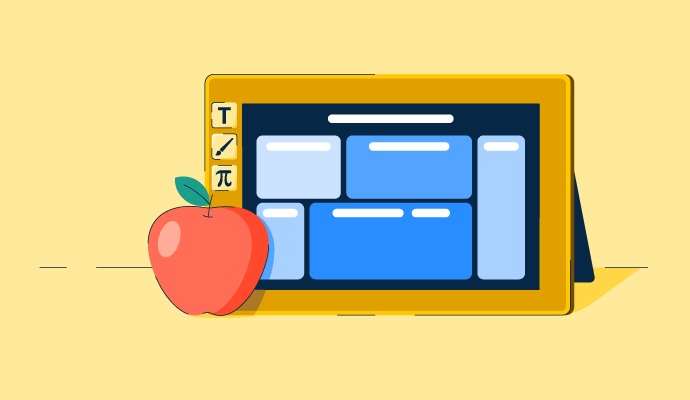March 30, 2023
 by Mara Calvello / March 30, 2023
by Mara Calvello / March 30, 2023

Teachers always have a lot on their plate, from organizing a potentially hectic classroom to grading homework.
And, of course, let’s not forget about creating and leading lesson plans.
A lesson plan is a teacher’s guide for instructing students. It includes how a lesson should be taught and how the learning is measured. Providing a lesson plan helps teachers become more effective.
Teachers rely on precisely constructed lesson plans to remain organized and ensure every lesson is the best it can be. Lesson plans also ensure the entire class is spent teaching new concepts and having meaningful discussions instead of figuring them out in the moment.
To create lesson plans, teachers often turn to curriculum management software to create and implement lessons for all types of classroom settings. From K–12 to higher education, teachers turn to these tools to deal with all tasks related to brainstorming, developing, integrating, and launching their lesson plans.
Whether your school has lessons in person or you’re teaching a blended learning program, creating an effective lesson plan leads to several benefits.
Lesson plans don’t have to be complex to be effective; you just need to make sure they’re thorough and accurately reflect what you need to get done. The structure of your lesson plan will grow and evolve as your classroom and teaching style does.
Many key elements need to be a part of a lesson plan. Since every aspect plays an important role in the learning experience for students, it’s important that they’re constructed with as many details as possible.
Below are the components of a lesson plan.
Note: Ready to get started on your lesson plan? Download our free lesson plan template, suitable for learners in high school, middle school, homeschool, and even pre-k.
Figuring out key objectives is the first element of lesson planning. Objectives clearly state what students are supposed to know after the lesson is complete. Teachers should include student goals, items to review, and lesson expectations. Every objective within the lesson plan should be related to an actionable item for students.
When coming up with the learning objectives, ask yourself questions like:
For example, algebra teachers have the objective that students will be able to comprehend and solve certain algebraic equations at the end of the lesson. This should be specified in a math lesson plan.
As you create lesson objectives, remember that it’s easier to measure whether or not the lesson was a success when it’s centered around specific goals.
Tip: Objectives typically begin with the phrase “Students will be able to…”
Next, consider the needs of your students as you create the lesson plan. Are you introducing the students to new material or a new topic? Or are you reviewing what was already taught? It’s important to tell students what to expect at the start of each lesson so they can stay focused and have the best chance of meeting your objectives.
This part of the lesson plan covers why you’re teaching the specific lesson. You’re likely instructing in a state with educational standards that outline the information students need before graduating. In almost all states, these are the Common Core Standards.
Did you know? Florida, Virginia, and Texas refuse to adopt The Common Core standards. They have their own state standards.
When reviewing material or going over handouts and worksheets, some students may require extra encouragement than others, so identify the needs of the students in the lesson plan to help you prepare.
Another important section in a detailed lesson plan is the list of materials needed to teach the lesson and measure student outcomes. Without it, you may show up to class that day missing something, which takes away from what you’re trying to teach.
Materials depend on the grade level you’re teaching, but some common types of lesson resources you may need listed here.
Outlining these materials and teaching resources helps you prepare before the lesson begins. You don’t want to walk into class realizing you forgot to print a worksheet!
Your lesson plan should include a procedure, or a breakdown of how each lesson will progress in the classroom. These step-by-step instructions take you through all the lesson plan details, from when the class starts until the bell rings.
For this section to be as helpful as possible, be as detailed as you can. A good place to start is choosing the type of activity that helps students get to the lesson objective. In this section, ask yourself questions like:
You should also include learning activities and exercises that students complete to gain new skills or knowledge. Estimate how much time each activity needs and build in extra time for when students have questions or need additional explanations.
Since this makes up most of your lesson plan, you should list all the lesson activities and action items you’re responsible for leading. This could be a guided discussion with a list of questions to cover or vocabulary words you need to run through. You can make this as thorough as you’d like – whatever helps you stay on track.
These activities should encourage students to highlight various learning styles and thinking abilities.
The perfect lesson plan doesn’t exist! That being said, you can set the class up for success by including possible challenges, problems, or roadblocks and their outcomes.
For instance, it’s common for learners within your class to be at different levels of comprehension, writing skills, or understanding methods. So, be inclusive and flexible with the teaching methods you’ll need throughout the lesson.
Once you’ve established roadblocks, it’s always best to set a time frame for each lesson plan. Setting a specific and realistic timeline for each activity helps achieve maximum engagement with students.
Instead of trying to fit everything in at once, lesson plans can be divided into different days of the week or converted into a weekly plan. This narrows down the list of the most important concepts, exercises, or ideas of the lesson.
When setting a time frame, prioritize the learning objectives and always give yourself extra time at the end for questions or essential discussions. You shouldn’t treat this schedule like a set of rigid rules you never deviate from. If you give yourself 20 minutes to explain a topic or theory, but the students grasp everything in 15 minutes, move on!
At this stage, you choose a method for measuring which aspects of the lesson plan were most effective.
You have options for which assessments to lead throughout the class, but some of the most common are below.
You can also choose an in-class assignment, like a workbook or homework for students to complete before the next class.
In this section, outline any additional notes, comments, or things to remember. By leaving a small section for additional notes, you have the freedom to go back and jot down any thoughts or ideas that may come up.
So, how did it go?
As you reflect on the lesson, ask yourself questions like:
Now comes the fun part! Being an educator isn’t an easy job. It requires a lot of prep work and planning to run and manage a successful classroom. By following these tips and using this free resource as a starting point for creating lesson plans, you’ll be on your way in no time.
Ensure your lesson runs smoothly from start to finish by incorporating one of these 14 classroom management strategies.
Mara Calvello is a Content and Communications Manager at G2. She received her Bachelor of Arts degree from Elmhurst College (now Elmhurst University). Mara writes content highlighting G2 newsroom events and customer marketing case studies, while also focusing on social media and communications for G2. She previously wrote content to support our G2 Tea newsletter, as well as categories on artificial intelligence, natural language understanding (NLU), AI code generation, synthetic data, and more. In her spare time, she's out exploring with her rescue dog Zeke or enjoying a good book.
During our keynote session of G2 Reach 2022, I was excited to interview Henry Schuck, to...
 by Godard Abel
by Godard Abel
Earlier this year, at our G2 FY25 kickoff in Chicago, we had the privilege of having...
 by Godard Abel
by Godard Abel
As a 5x SaaS entrepreneur, I know that scaling a startup for high-growth requires a blend of...
 by Godard Abel
by Godard Abel
During our keynote session of G2 Reach 2022, I was excited to interview Henry Schuck, to...
 by Godard Abel
by Godard Abel
Earlier this year, at our G2 FY25 kickoff in Chicago, we had the privilege of having...
 by Godard Abel
by Godard Abel


